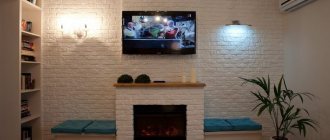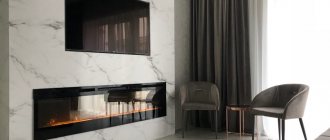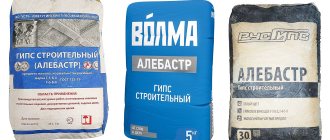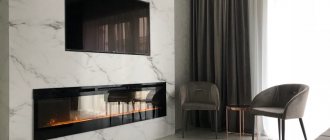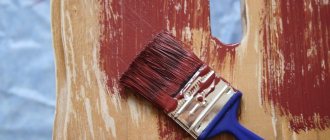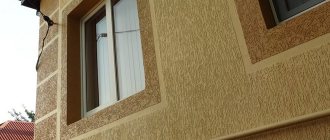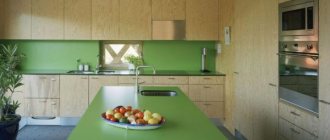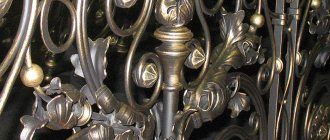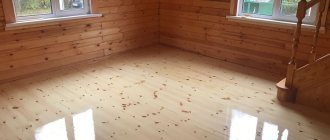Previously, gypsum was used in art to create sculptures and in medicine to fix fused bones. But enterprising workers were able to discern properties in it that made it possible to create building materials with excellent performance and decorative qualities.
On store shelves you can find plasters, putties, dry mixtures, decorative elements in the form of slabs, stones, and stucco figurines. The mineral has high adhesion, which requires careful selection of products for painting it.
Methods of painting gypsum products, materials for tinting, tools
Gypsum has excellent adhesion to a wide variety of paints and varnishes; there are many ways to paint it:
- In the mass - the simplest type of finishing: the pigment is added to the gypsum mass before the products are cast into a mold. The mass must be thoroughly mixed to obtain uniform color. After installation, the stucco molding can be varnished to protect it from dirt. The method is often used when independently casting facing tiles to look like brick or stone; painting gypsum mortar for classic stucco in dark colors is used less frequently, since later difficulties may arise when repainting. It is almost impossible to achieve uniform dosing of coloring pigment in different batches at home, but when tinting 3D panels with fancy relief in a mass, it is the uneven distribution of color that can give an additional and always unique effect.
- Brush - used if it is necessary to imitate the texture of stone, brick, wood, to work out small details when painting in one tone.
- Using a spray gun (an alternative is an airbrush, garden sprayer) - we get an even tone over the entire surface to be painted, the method requires a certain skill in operation; with deep reliefs, unpainted areas may appear.
- Immersion in a solution is the most reliable way to obtain an even, single-color coating, but this increases paint consumption.
Color pigment for coloring gypsum mortar
Brushes for painting gypsum products
Spray gun
Colored solution for painting gypsum products
Let's consider how to paint a decorative gypsum stone. Painting gypsum stucco can be done with various compositions:
- acrylic;
- water-emulsion;
- pentaphthalic;
- limestone;
- silicate;
- silicone;
- latex.
When choosing how to paint plaster stucco molding, focus on the desired texture:
acrylic paints and varnishes give a satin finish, water-emulsion paints give a matte finish, pentaphthalic compositions are glossy and do not require varnish. Silicate, silicone and latex compositions have a rich range of colors, many interesting textures - stone, velvet, velor, Venetian, they form a moisture-resistant film on the surface of the stone, but their cost is much higher than that of acrylic and emulsion ones.
Materials for painting stucco
Most often, acrylic, lime and water-emulsion compositions are used, as they are more economical. The easiest way to achieve a metallic effect is to use car paints in aerosol packaging. To obtain some types of textures, natural drying oil is required. If you do not plan to frequently change the color scheme of the interior, then paint and varnish materials should be chosen with a service life of at least 10 years. To increase the adhesion and strength of the product, you can add up to 5% of the volume of PVA glue to the paint.
Copper or iron sulfate is used as an impregnation for gypsum. Copper gives plaster a blue tint, iron gives it a yellowish tint. To paint, tiles or decorative fragments are immersed in an aqueous solution of vitriol for 2 hours, while the parts should not touch, otherwise spots of different shades will appear on the surface.
When varnishing finished products, carefully choose the composition: a varnish with a strong gloss can look kitsch in some interiors due to its shine, so it is better to choose a matte or low-gloss finish.
In addition to the spray gun, brushes are used in the work - flat fluted and paneled, with a rounded end, with soft or hard bristles. The hair of the panel brushes is kolinsky, squirrel or badger, fluffy. For shading and texturing, use brushes with hard bristles and French knit bristles.
Tampers made of rags and foam rubber also help to shade the boundaries of the color; they are made manually from materials that are found in every home: most often by tying a piece of sponge or fabric to a wooden stick and wrapping it with thread or wire.
Painting stucco molding with small relief details at a height requires the construction of a scaffold so that all unpainted areas are visible and do not strain your hands.
How to paint artificial stone?
Painting the material at home is usually necessary when purchasing unprocessed products or making products yourself. In the second option, it is better to provide for painting the gypsum mass. This will allow for surface painting only to highlight the desired areas.
If, when making a stone yourself, you take care of its color in advance by adding color to the gypsum mass, then less effort and time will be spent on the entire coloring process
Painting plaster in general is not very easy; it requires care and a lot of time. In addition, the result when choosing a certain color is not always the desired one. Therefore, it is recommended to test all formulations in advance.
For the front coating, various types of dyes can be used to give the parts the desired shade.
Acrylic paint
The water-based solution is quite popular; it allows you to decorate and protect the surface. This material has a number of properties necessary for artificial stone made from a gypsum mixture:
- Elasticity. Cladding elements are subject to thermal expansion, which can lead to the formation of surface cracks. Due to a little elasticity, this problem will be eliminated.
- Vapor permeability. This parameter is very important for plaster, especially inside the house. The fact is that this material helps create a microclimate in the room by absorbing and releasing moisture.
- Resistance to various types of influences. Of course, paint will not protect parts from strong mechanical influence, but it will protect them from ultraviolet radiation and excess water.
Painting with acrylic paint will add additional protective properties to artificial stone, which is especially important in rooms with temperature changes and high humidity.
If you want to obtain high moisture resistance, purchase a mixture with the addition of silicone. A distinctive feature of acrylic compositions is that they easily change their color; for this, tint is used.
Vitriol
Iron and copper sulfate are used as impregnations. The main purpose of these mixtures is to enhance the strength of parts, but there is also a side effect - coloring. The iron variety gives the stone a yellow tint, and the copper variety gives it a blue tint.
The dry composition is diluted with water in a suitable container, the elements are immersed in the solution for two hours. The main thing is to place the fragments so that they do not touch each other, otherwise stand-out areas will appear.
Vitriol gives the gypsum a beautiful yellow tint, but to achieve a resemblance to natural stone, additional paint is applied to individual sections of the tile.
stain
For gypsum, compositions are mainly used that are also suitable for concrete artificial stones. They are monochromatic mixtures. There is a rich palette of shades, but if necessary, staining is done with wood stain.
There is also an acid stain
It should be handled with great care. Much depends on the composition of the gypsum tiles, so it is recommended to test the mixture on one product
Painting artificial stone with wood stain
Other types of solutions
Painting can be carried out in other varieties that color the surface of the stone:
- Any options intended for gypsum.
- Varnish of various modifications.
- Impregnations. Many of them not only improve product quality, but also affect appearance. For example, a penetrating mixture with a wet effect adds shine to the surface and creates the illusion of moisture.
- Self-prepared compositions. The main thing is the correct selection of components.
Specialized paints that imitate natural stone
Techniques for applying paint compositions
Plaster has been painted in interiors and exteriors for thousands of years, so many techniques have been developed. Let's look at the main ones:
- Simple coloring;
- Multi-layer painting;
- Gilding, silvering, bronze plating;
- Creation of relief;
- Patination;
- Application of a coating that imitates natural materials - marble, granite, wood, brick;
- Finishing with decorative plaster.
Before starting work, you need to make sure that the paint has the correct consistency: not too liquid, otherwise drips will appear, not too thick - this will lead to an increase in the thickness of the layer and overspending. When painting with brushes, it is necessary to apply not too much composition so that there are no drips or splashes. The brush should be cleaned of excess paint on the edge of the can. Stray hair that has fallen from the brush should be immediately removed with a flute or pad before it has time to dry to the surface.
The second mandatory condition is that the gypsum product must be dry and clean; the purchased decor must be kept for 2 days at room temperature before painting. Before changing color, the plaster must be sanded - a very difficult task, especially with deep relief.
Begin applying the paint layer from the deepest areas of the relief, painting small details with thin soft brushes. The range of brush numbers is 1-24, depending on the size.
The process of painting stucco
Paints that are too thick are diluted up to 10% with water or up to 5% with solvent, depending on the composition. Work with paints and varnishes is carried out according to the manufacturer's instructions. The primer and paint must be compatible in composition; it is advisable to purchase them from the same company.
The paint is applied in 2-3 layers, drying every 3-6 hours. Application of the composition, drying time, compatibility of paint and primer is always determined according to the manufacturer's instructions.
Let's take a closer look at the techniques.
Simple basic coloring
For simple painting in one tone, take acrylic, lime or water-based paint of the desired color, a primer of the appropriate composition, and, if desired, varnish. When drying, gypsum loses its color intensity, therefore, and also to protect the surface from damage, it is coated with varnish. It is better to use water-soluble varnish - it has almost no odor and dries quickly.
It is better to do the work not with a brush, but with a spray gun or an airbrush - this way the primer and coating will form a more even layer, reducing consumption, but it is difficult to paint over deep depressions; they will have to be finished with a brush.
Painted plaster products
How to paint decorative plaster tiles:
- The dry surface, free of dust and dirt, is primed. The primer reduces absorption, reducing the consumption of the base compound, while at the same time ensuring adhesion of the layers. It is advisable to tint the primer - this will also reduce the consumption of the base paint and increase the brightness of the color.
- The soil has dried - apply a layer of paint; on an untinted base you will have to repeat the operation 2-3 times.
- Dried plaster is coated with varnish.
When using new generation acrylic paints we obtain the following coating:
- with lotus effect (contains wax) - resistant to dirt;
- the glow effect is provided by the content of marble dust or finely ground quartz sand;
- colored and shiny inclusions - with fiber or chips.
The latest technologies make it possible to achieve original effects on the surface.
Multilayer painting
Painting decorative gypsum stone in several layers is used if the product needs to achieve a smooth transition from one color to another, for example, painting tiles with a voluminous decor in the form of an autumn maple leaf or flower. We take paint of 3-4 shades:
- yellow;
- orange;
- crimson;
- terracotta.
Painting gypsum stucco begins with the lightest tone; apply a layer of yellow paint over the primed base. After it dries, apply the orange tint closer to the edges. We smooth out the border of the flowers with a pad made from a soft cloth or sponge. Along the edge of the leaf there is a section of crimson coloring. We also smooth out the border, achieving a smooth transition from one color to another. We paint the background with terracotta and draw veins on the leaf.
Painting stucco
Gilding, silvering, bronzed
Painting plaster stucco with gold, silver or bronze paint gives the interior solemnity and aristocracy. This technique is typical for classical styles of architecture from Renaissance to Empire. In the classical technique, gilding was done with thin leaves of gold leaf or gold leaf; now they often use metallic paint in aerosols. Traditional gilding is performed as follows:
- The surface is prepared - all chips and cracks are repaired, sanded with a special machine or sandpaper manually, dust is brushed off with a brush or vacuumed, the surface is primed with an industrial compound or glue;
- A layer of gold plating paste mixed with glue is applied over the dried primer;
- Next, apply gold leaf or gold leaf with a soft bristle brush and carefully, so as not to tear, smooth it to the base, repeating the relief of the stucco.
Painting plaster gold
It is much easier and cheaper to use acrylic compositions with a metallic effect in aerosol packaging: they dry quickly, have almost no smell, and apply well. Primer and varnish are selected according to the recommendation of the manufacturer.
Painting gypsum bronze is done over a primer with heated drying oil. Powdered bronze is diluted with varnish and applied with a brush.
Process sequence:
- Preparation of the base - cleaning, dust removal, priming;
- The surfaces are painted 3 times - 1 layer is the lightest, the entire product is covered with liquid paint, after drying, the convex areas are processed with a grinding machine or sandpaper, the dust is brushed off; 2nd layer is thicker, paint the recesses using paint with the addition of bronze powder; 3rd layer - paint thinned with turpentine, with the addition of beeswax to give a metallic shine. In order to imitate patina, some convex areas are painted with the addition of chromium oxide, or a mixture of bronze and graphite is used. Another option is to apply a solution from a mixture containing silver nitrate (10 g), vinegar (100 g), water (300 g) over the painted layer of bronze powder in varnish. Due to oxidation, bronze develops a patina.
- The painted and patinated surface is saturated with a solution of wax in turpentine until absorption stops, and wiped with velvet cloth.
Bronze painting of plaster
Painting plaster like silver
Now the process is significantly simplified: metallic paint is sprayed from a can on the primed surface, and areas of unpainted paint are corrected with a thin squirrel brush. Often, individual elements or edges of protruding parts in a pattern are trimmed with gilding. In this case, it is important to first protect areas that do not need finishing. This can be done using masking tape or a portable cardboard screen.
Creating relief
You can emphasize the reliefs of stucco decoration or plaster tiles using paint of 2-3 shades of saturation. They start with the lightest tone, covering the decor completely, paying special attention to the convex parts - there should be no unpainted areas here.
Then they take a darker shade, cover the buried parts of the relief with it, smoothing out the transition of tones with a brush with stiff bristles without paint: from light to dark. Accidental splashes or incorrectly applied color are immediately removed with a dry brush or rag.
Stucco relief
Lastly, the background or the deepest depressions are covered with the darkest colors, also achieving a gradual color transition with a hard brush.
Patination
If we want to achieve the look of an ancient, authentic finish, we paint the gypsum stucco molding with an aging effect: the base is tinted with primer or natural drying oil to a yellowish tint, then the main coloring composition is applied with fillet brushes. To paint sunken areas, we use thin brushes with soft bristles. You can achieve transparency of the paint layer by changing the thickness of the paint layer in different areas: a thicker layer is applied with a swab (rag or sponge), a thin layer is shaded with a brush with short, stiff bristles.
Intermediate gypsum patination process
The product can be patinated using a grinding machine, sandpaper or a metal brush: the painted, dried surface on the relief convexities is sanded, depicting abrasions. This technique looks great on stucco painted to look like wood (brushing effect) or coated with metallic compounds.
Plaster patination
Plaster patination
Application of a coating that imitates natural materials - marble, granite, wood, brick
Painting gypsum tiles to look like stone - this design technique for decorating gypsum is used to achieve an imitation of natural stone. Painting plaster to look like marble using a traditional technique involves using heated drying oil on a well-dried stone. Uneven absorption of oil by plaster produces stains reminiscent of marble veins. The dry product is coated with varnish to protect it and obtain shine.
Painting plaster to look like marble
To give gypsum tiles the appearance of granite, they use the spraying technique: the tile is primed, painted in the main background, then several brushes of varying degrees of hardness are taken and paint in colors different from the main background. Apply excess paint to the brush and use your fingers or a special tablet to ensure that the paint splashes onto the decor. Brushes of different hardness and bristle lengths, shades of paint produce splashes of different sizes and colors, resulting in a texture reminiscent of granite grains. To perform this technique well, you will first have to practice on an unnecessary sheet of cardboard.
Painting plaster to look like wood is done with a stain that imitates the colors of different valuable types of wood. You can get a characteristic wood pattern by making longitudinal movements with a rigid flute with different pressure; this results in uneven thickness of the layer of paint composition.
Painting to look like terracotta is done with rosin and varnish diluted in industrial alcohol.
How to paint decorative bricks made of plaster: cladding with decorative bricks looks completely different in different interior styles; the painting method is simple or multilayer.
Painting plaster to look like granite
Painting decorative gypsum bricks
Country styles are characterized by painting gypsum tiles to imitate brick in white, cream, or grayish colors with a varnish coating that imitates glaze. Gypsum tiles are dipped in paint of the desired tone, dried and varnished.
Painting gypsum tiles for a loft style, when the look of clinker brick is required, requires multi-color painting: terracotta, ocher and blue-black pigments will create a color transition characteristic of hand-made clinker tiles. To imitate hand-made clinker, the surface of the ingot is pre-treated with sandpaper and a brush with metal teeth, adding irregularities characteristic of hand-made products.
Finishing with decorative plaster
The latest technologies provide paints and varnishes that imitate any surface. Now you can buy ready-to-use decorative mineral plaster with quartz grain or crushed marble of different fractions, which will give the tiles the appearance of natural stone with a wild, ground or polished surface.
Silicone and latese paints replicate the texture of Venetian plaster, patina, velor or velvet. Without multi-layer painting, you can achieve many unique color and texture effects with just a spray gun. The same compositions will give the gypsum moisture resistance.
Painting 3D gypsum panels is done using a variety of techniques, but since their pattern is very active, you should be wary of the idea of bright tinting. Basic painting in one color with light accent tinting of individual parts is best. The easiest way to decorate is with a spray gun.
Painted 3D panels in the interior
Painted 3D panels in the interior
Using plaster varnish
Standard plaster products are grayish or white, and painting them or tinting them with a colored varnish will help give the wall the desired look. With its help, you can design the surface in an original way and stylize it in accordance with the chosen direction in the interior. Varnishing helps increase moisture resistance, because gypsum products deteriorate when in contact with moisture. After varnishing in several layers, the decorative stone will be suitable even for finishing wet rooms. Also, applying varnish reduces the susceptibility of the tiles to impact.
Varnish for gypsum decorative stone: types
There are varnishes of different types, compositions, with different characteristics and properties on sale.
Shellac varnish
This type is usually used in decoupage, but it is often used in finishing work. Shellac is alcohol-based, so it works well with plaster. It can be applied as a stand-alone coating or over any paint. Shellac creates a thin polishing layer that looks stylish and very attractive.
The composition can be transparent and colored. There are even special varnishes with an aging effect that are used to give the base a vintage look. If you combine the product with rosin in a 1:1 ratio, a protective film will be created on the surface of the plaster, eliminating the appearance of dirt and giving the wall a marble look.
Acrylic varnishes
Acrylic-based varnishes perform a decorative and protective function. They are moisture resistant, do not deteriorate from household chemicals, ultraviolet radiation, temperature changes, dry quickly, and do not have a pungent odor. When thickening, acrylic varnish can simply be diluted with water.
In appearance, acrylic coatings can be matte, semi-matte, or glossy. Matte ones help give the stone the appearance of a natural, rough material. Semi-matte varnishes work in a similar way, only their transparent varieties may leave a slight light coating after drying. Glossy products shine and lead to glare, which must be taken into account when planning the decor in the room.
Oil varnishes
Oil varnishes contain artificial resins and plant extracts. After application to the gypsum stone, a thin film is formed, protecting the material from any external factors and extending its service life. Oil-based varnishes can be transparent or colored, glossy or matte. After this product has dried, the surface of the decorative stone will look a little darker than initially.
Yacht varnishes
The most durable, long-lasting and reliable varnish for stone is considered to be yacht varnish. It has a high degree of water resistance, making it suitable even for handling yachts. Contains solvents, has an unpleasant odor and is more suitable for outdoor use, although after complete drying it ceases to be toxic. For maximum surface protection, yacht varnish is applied in 2 layers.
Varnishing rules
Before applying the coating, you need to make sure that all elements have dried well after priming or protective hydrophobization. The adhesive to which the decorative stone was attached must also dry out, otherwise the integrity of the cladding may be compromised.
Tips for varnishing stone:
- rough parts should be sanded before spraying varnish; fine-grain sandpaper is well suited for this purpose;
- if impregnation was applied to the stone, you need to read the instructions for it and clarify the possibility of subsequent varnishing and compatibility with a particular varnish;
- shiny compositions reduce the effect of the naturalness of the stone, so for country styles, Provence and other styles striving for naturalness, it is better to choose matte products;
- Before varnishing, be sure to wipe off all dust from the stone;
- during work, do not wet the wall or elements - they quickly absorb moisture;
- The most convenient method of varnishing is spraying from a spray gun or airbrush.
By using your imagination, you can use decorative stone to find very interesting solutions even in a small apartment. This material looks unusual, fresh and gives the house a special flavor, fills it with warmth and comfort.
Results
Painting plaster yourself is possible if you follow the basic rules:
- thorough surface preparation;
- mandatory priming;
- applying paint in 2-3 layers;
- varnish coating;
- use of compatible compounds;
- follow the paint manufacturer's instructions.
In the absence of skills, it is necessary to perform trial operations on samples until a stable positive result is obtained.
Materials for painting stucco
Painting plaster with your own hands is possible, but it requires certain skills, time and accuracy. Carry out work in a dry room with good ventilation, allowing the intermediate layers to dry out. And everything will work out!
Painting Tips
In order for the painting job to be successful, you must first prepare the necessary materials. You will need:
- Sponge made of rubberized material;
- Sandpaper;
- A piece of cotton fabric;
- Paint sprayer;
- Sanding file;
- Degreasing solution;
- Dye;
- Set of brushes;
- Impregnating suspension;
- Compressor.
Finishing with colored decorative stone is often used in landscape design and facade work, so the choice of paint must be taken especially responsibly.
Painting requires compliance with certain rules:
The stone is dried for 24-48 hours before painting; The old cladding is pre-polished so that the paint does not crumble; Impregnations are used strictly in accordance with the instructions
It is also important to consider the compatibility of impregnations with dyes; To make the surface shiny, you can use a varnish coating. However, it does not always look beautiful, since the effect of the naturalness of the material is lost.
If you follow these tips, the coating will look natural and the paint will last a long time.
How to paint artificial stone
With such a variety of materials, it is quite difficult to choose what to cover with decorative stone.
The most popular options are:
- acrylic paint;
- vitriol;
- stain;
- various colored solutions.
Each of the materials has application features and properties.
Acrylic paint
Water-based wall paint is popular because it not only allows you to paint walls, but also protects the surface from weather conditions.
Acrylic paint for decorative stone has a number of advantages:
- elasticity. Due to changes in temperature conditions, cracks and deformations can form in the surface. Due to elasticity, this problem is eliminated;
- vapor permeability. This material perfectly absorbs and releases moisture;
- the ability to easily change color by adding color.
- resistance to ultraviolet radiation and moisture.
If you need to increase moisture resistance, you can choose a mixture with the addition of silicone.
Vitriol
Iron and copper sulfate are used as impregnation for walls made of natural stone. Such compositions increase the strength of parts. However, these compounds change the color of the treated surface. Iron sulfate turns the stone yellowish, and copper sulfate turns it blue. If this is exactly what you need for decoration, the elements should be immersed in the solution for a couple of hours in this way. So that they do not touch each other.
stain
Decorative gypsum coating for stone walls is treated with the same compounds as concrete. On sale, these mixtures are monochromatic, but if you want to diversify the palette, you can use wood stain. Acid stain is popular, but you should try the treatment on one plate before applying to all walls.
This is important, since gypsum stones can vary in composition
Other types of solutions
There are other options for solutions that can be used for coloring
When choosing what to paint the surface of walls to look like stone, you can pay attention to the following materials:
- varnishes;
- impregnations that can not only color the surface, but also improve their quality. Wet effect mixtures can create a shiny film on the stone and create the visual illusion of moisture on the wall;
- paints for plaster of any modification;
- compositions created with your own hands. In this case, the main thing is to choose the components wisely.
Compositions that can imitate natural stone have appeared on the building materials market. However, their cost is not yet available to everyone.
Painting in bulk
There is nothing easier than painting artificial stone using this method. We take the pigment, dissolve it in water, then add plaster and make a solution. Then pour it into the molds.
Pros:
- Fast painting method;
- All tiles are painted (inside and outside);
- No fading.
Cons: You can only get 1 color.
After drying the stone, the color will fade, so only testing can determine the final color of the stone. I mixed 1 kg of gypsum and added different amounts of pigment: 3, 6, 10, 15 grams. The main thing is to write everything down so that you don’t forget later how much pigment you added to which stone.
If you want to thank me for sharing my experience with you, then write a comment on this article with any question or suggestion. Perhaps from your comment I will get a topic for one of the future articles. Write a comment
How to paint decorative stone
To make the result of painting the stone pleasing, you must use waterproof acrylic paints. Acid dyes are also suitable as an option - such compositions are able to penetrate deeply into the structure of the decorative stone and resist fading quite well. Another advantage of such dyes is the short drying period.
When purchasing paint, you need to make sure of its high quality. It should not have clots or lumps; any fluctuation in the structure indicates possible problems that need to be eliminated before staining begins.
Using water or a primer, bring the paint consistency to the desired state. In addition to paintwork, you can use plaster varnish - this applies to gypsum stone. After treatment with this composition, gypsum tiles receive a uniform color. The varnish itself is applied evenly, without streaks, dries quickly and does not flow down the surface.
What should be avoided is the use of quick-drying nitro-varnish dyes - after drying, such a composition forms a thin film, which will inevitably flake off when the temperature changes.
The use of quick-drying nitro-lacquer dyes should be avoided.
Another worthy option is a liquid or dry dye that needs to be added to the water. To obtain a solution of the required saturation, mix 1 teaspoon of pigment and 400 ml of water and acrylic primer.
To avoid mistakes, read the instructions that come with the paintwork from the manufacturer.
Tool selection
To determine the list of tools that you need to have available to start work, it is worth assessing the quality of the surface. If the surface is old, then more tools will be required; for new tiles, there may be fewer tools. On average, the list of accessories consists of:
- Vacuum cleaner - necessary for cleaning contaminated surfaces and removing dust;
- Sanding accessories - this can be either a sanding machine or sandpaper;
- Sponges and brushes - necessary for touching up colored elements and hard-to-reach places;
- Spray gun or airbrush.
Coloring option
In bulk
It is considered the most practical and best way. In this case, coloring pigments in powder form, which are used for concrete, are added directly to the gypsum solution. Thus, you receive a product that is painted from the inside. When cutting or chipping, you will not see the white base.
A beige or yellow solution is best, and in polyurethane form, parts of the stones can be painted with liquid pigments using a brush.
For this:
- take ½ tsp. color (pigment);
- add 200 ml of water;
- add 200 ml of any acrylic primer.
When the stone has set, remove it from the mold and dry it, and after laying it on the surface, apply a matte water-based varnish to it.
This option for painting decorative gypsum stone is the most effective and almost all manufacturers use it. That’s why we can see these kinds of products in stores. The disadvantage of this method is the rough and unnatural painting, which can be observed at close range.
By making gypsum artificial stone yourself, you have the opportunity to work on naturalness by carefully painting parts of the stones in the mold. Of course, no one will do this on an industrial scale, otherwise the price will increase significantly.
Below we will propose another painting technology that will help make a product from gypsum tiles that is more similar to natural stone. You will learn how to paint artificial stone so that it has the same natural veining and color scheme as natural stone.
Surface
Prepare:
- water-based (coloring pigment);
- water;
- spray or brush.
The instructions are simple - you need:
- add a coloring pigment to the water, you can even add several at once;
- dip a brush into the solution;
- saturate gypsum tiles with it.
Artificial gypsum stone has unique properties of developing shades that are similar to natural ones due to the absorption of tinted water.
In order to give gypsum stone the desired shade and color, you do not need to have an artistic education. Dip the brush into the colored water and paint the stone as you see fit.
Then you can tint some with a dark solution consisting of color pigment and water. You shouldn’t think too much about the palette, since each gypsum tile, even with the same texture, will absorb the solution differently, which will allow you to create an individual pattern each time.
You can also use any sprayers for work, for example:
- spray gun;
- sprayer for glass cleaning products.
Pour paint diluted with water-based tinting paste into a container and spray it onto the gypsum tiles. It is better to use several of these sprayers with different colors in your work so that you can treat different places on the stone. Then the painting process will be better and faster.
The advantage of painting yourself
- The store offers artificial stone in standard colors and with obvious artificial coloring. It does not have natural colored veins, like natural ones.
- You can purchase products in white or plain beige, glue them to the walls, and then paint them on the spot with water and coloring pigments diluted in it. This method makes masonry much more natural. (See also article.)
- Once the plaster stone has dried and become faded and pale in appearance, open it with any silky matte or matte varnish. This way you can restore the color saturation of the product, strengthen and protect its surface.
- If you want to achieve a “wet” effect on artificial stone, use varnishes, but be aware that this will slightly reduce the naturalness of the material.
Painting
painting decorative stone
To paint artificial stone, use brushes with a roller or a spray bottle.
In particular, thanks to the spray gun you will save on the consumption of paint and varnish materials, shorten the repair period, the paint will lie much more evenly, it will be easier to adjust the saturation and depth of color, and during the work the entire painting area will be visible at once.
You can also use brushes with a roller, however, the paint consumption will increase several times, and the quality of the work will be slightly lower. However, you will need brushes in any case, for example, for touching up contrasting areas, drawing colored stripes, creating a mosaic panel, simulating veins or inclusions, etc.
So, make sure that the hydrophobic impregnation is completely dry. Let's move on to painting.
To begin with, it is advisable to practice in a small area to check the results of your work. Then apply the paint to small areas of the wall, holding the sprayer 40 cm from the cladding surface. It is better to set the pressure in the tool to 3-3.5 atm. By the way, two sprayers with different shades of dye are often used simultaneously.
But with brushes you can effectively treat each tile separately, showing your creative imagination, for example, strengthening or weakening the desired halftones, drawing veins, stripes, etc. The technology of the work is simple - dip the brush in the composition and paint.
It is worth noting that decorative stone, especially gypsum, usually absorbs paint unevenly across individual tiles. But this is completely natural for him. Such heterogeneity, with an individual pattern for each tile, on the contrary, will make the decorative cladding more similar to natural stone.
In principle, this paint job can be considered complete. After some types of paint, such as acid paints, the base must be thoroughly washed, dried again, and then covered with hydrophobic impregnation.
Wait for the surface to dry and enjoy your updated artificial stone wall.
We wish you a successful renovation!
How much does it cost to install gypsum 3D panels?
Installation of gypsum panels
| Installation of gypsum 3D panels without sealing seams (depending on the complexity of the terrain) | from 2200 rub. per sq.m. |
| Facing the outer and inner corners (cutting panels at 45 degrees, puttying and sanding the joint) | 3000 rub. per sq.m. |
| Restoration of damaged panels | 3500 rub. per sq.m. |
| Dismantling panels | 400 rub. per sq.m. |
How to paint
Before painting a gypsum stone, care must be taken to reduce its hygroscopicity. To do this, it must be endowed with a water-repellent effect. This can be done using special compounds. At the same time, the vapor permeability of the material is not affected. You can find a ready-made solution in hardware stores or dilute it yourself from concentrates. By the time of application, the gypsum stone should already be thoroughly dry. It is necessary to remove dust from it. The composition is applied using a brush or spray gun.
Lucky
The following types of varnishes can be used to coat gypsum stone:
- acrylic;
- oil;
- yacht
Acrylic varnish is water-based. It contains various resins. The consistency is similar to thick milk. It can be used for interior and exterior decoration. Most often, such varnish provides a finishing coat that will protect the base layer. It creates a special film on the stone that has a water-repellent effect. It also protects against exposure to ultraviolet rays. The dried surface is easy to clean using various products. Available in glossy, semi-matte and matte varnish. Each of them has its own unique effect. Glossy varnish gives gloss to gypsum stone
When using it, it is important to maintain moderation, because
the surface will strongly reflect light, which can spoil the idea. Matte varnish on gypsum stone looks solid. It creates an atmosphere of comfort and peace.
Oil-based varnish can be used with the same success for gypsum stone. It provides excellent protection to the cladding due to the fact that before complete drying a film is formed, which remains after drying. It increases resistance to mechanical stress. To achieve the required consistency, special solvents are used. In terms of surface matte level, oil varnish has the same properties as the previous type. It is worth considering that this varnish may darken a little after drying.
Yacht varnish will provide the most protection for gypsum cladding. It must be applied in a thin layer to avoid drips, which will be difficult to get rid of later. It dries in about a day. This period may be extended due to low temperature or high humidity. After drying, another layer is applied. In some places, you may need to sand the surface with fine sandpaper to remove drips.
Paints
Painting plaster cladding is easier than it might seem. One option would be to add pigment to a water-based varnish. You can use water-based paint with the addition of any pigment. There are special pigments that are diluted with water. Gypsum will perfectly absorb the coloring base. In this case, you don’t have to try hard to draw lines. The manufacturer often colors the gypsum cladding himself by adding dye to the base. A video about painting gypsum stone can be seen below.
https://youtube.com/watch?v=BCqKYGOlK0k
